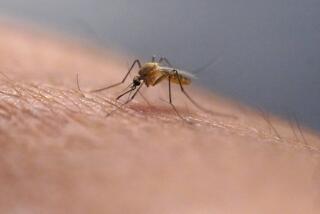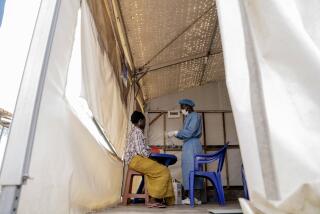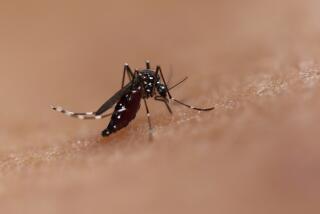An old scourge’s deadly comeback
WASHINGTON — Anna Manzanarez was a picture of good health. But about a week after catching what she thought was a bad case of the flu, the 28-year-old waitress from the central California coastal community of Seaside collapsed getting out of the shower.
The next day, despite intensive care at a hospital, she died.
Her death shocked her family, but the discovery of what killed her hit public health officials like a bolt from the blue: She had fallen victim to a virulent form of a mosquito-borne disease that had long ago been eradicated in the U.S. and was once close to being eliminated throughout South America as well.
The disease, dengue fever, is on the march again and beginning to make its presence felt in the U.S., with cases popping up in Texas, Hawaii and Puerto Rico. Last week, top health officials warned that a “widespread appearance” in the continental U.S. is “a real possibility.” Officials are forecasting outbreaks along parts of the Mexican border, although California is not seen as being at high risk.
What has raised the new threat for the United States from a disease scientists thought they had conquered in this hemisphere 30 years ago is a combination of globalization and, some think, global warming.
Thus far, cases of dengue fever in North America have tended to be scattered and affect relatively few people. But increased travel to and from South America, where a resurgence has made dengue widespread, is thought to be boosting the disease’s spread northward. And some experts suspect climate change is aggravating the problem.
“It’s starting to creep up from South America to the Caribbean,” Dr. Anthony S. Fauci, head of the National Institute of Allergy and Infectious Diseases, said in an interview. “If it can occur right at the tip of Texas, a disease which maybe people never heard of could actually appear here.”
Fauci, who helped lead the government’s efforts against AIDS, sounded the alarm on dengue in an article last week in the Journal of the American Medical Assn. He and his science advisor, Dr. David H. Morens, said more than 760,000 cases were reported in the Americas last year, of which some 20,000 involved the virulent form, known as dengue hemorrhagic fever. That is what killed Manzanarez.
Globally, “it ranks among the most serious infections, but most Americans don’t even have it on their radar screens,” Fauci said.
There is no vaccine against dengue, nor is there a drug that can cure it, although a race to develop both finally seems to be gathering momentum. Most people who get the less virulent forms of the virus recover on their own, although many experience the strong pains that have given dengue its nickname, breakbone fever.
Hawaii had an outbreak in 2001. Puerto Rico had 10,000 cases last year, and in recent years there have been several cases on the Texas side of the U.S.-Mexico border. Manzanarez apparently contracted the disease on a vacation in Mexico; she died on May 9, 2005.
Doctors treat the disease by trying to ease its symptoms, relying on the patient’s immune system to fight off the virus. But in the extreme form, the virus damages tiny blood vessels in the victim’s body, causing them to leak fluid. Blood pressure drops, and the patient can go into shock and die. Children are particularly susceptible.
“Like with Ebola, you can have blood coming out all over the place,” said Paul Herrling, a senior scientist with pharmaceutical company Novartis. “It’s an intensive-care situation. It’s horrible.” Herrling heads a research effort to develop antiviral drugs to treat dengue; other drug makers and the National Institutes of Health are working on vaccines.
All four types of dengue are found in the Americas, and the two types of mosquitoes that transmit it are present in the U.S. Dengue cannot be passed directly from person to person. After biting an infected person, a mosquito transfers the virus when it bites a healthy person. Theoretically, an infected traveler who returns from South America could spark an outbreak here.
The likelihood of such a scenario developing is the subject of a spirited debate among scientists. So is the role that global warming may play in expanding the range of the two mosquitoes that carry the virus: Aedes aegypti and Aedes albopictus (also called the Asian tiger mosquito).
Dr. Lyle R. Petersen of the Centers for Disease Control and Prevention said there was “clearly a problem” along the border with Mexico. But Petersen, head of the CDC branch that handles diseases transmitted by insects and other animals, disagreed with Fauci on the chances for widespread outbreaks in the rest of the country.
“The big issue is, will this extend beyond the border into the continental United States? The answer is, we really don’t know,” Petersen said. “Chances are that the risk at the current time is probably not too great.”
The reason, he said, is that the most efficient carrier of the virus -- Aedes aegypti -- is losing ground because of mosquito-control efforts. But Fauci pointed out that the second mosquito -- the Asian tiger -- was first seen in the U.S. in 1985 and can now be found in 36 states.
Fauci also suggested that global warming could turn the tide in favor of the mosquitoes.
“There is nothing definitive, but it’s very clear that as [temperatures] get warmer and warmer, the range of certain mosquitoes -- and the duration time they are able to circulate -- increases,” he said.
The areas that could be most susceptible to outbreaks would have to have the right combination of heat and humidity for mosquitoes to thrive; they include the Gulf Coast and parts of the Southeast.
However, a renowned dengue expert at the University of Hawaii, Duane J. Gubler, dismissed the role of warming as “junk science.” He cited other factors in the spread of dengue, such as increased global travel and the rise in the tropics of large cities with sprawling slums.
Gubler said America’s high standard of living offered protection from dengue, because homes have screened windows and air conditioning. “We have good houses, and pretty much hermetically sealed houses,” he said. “Usually people are in those houses watching TV.”
Yet Americans have shown that whatever their houses may be like, they are not immune to diseases associated with insects and the outdoors. Lyme disease, a bacterial infection spread by tiny deer ticks in woods and grasslands, has become a scourge in parts of the U.S.
And West Nile virus is transmitted to humans by mosquitoes that bite infected birds; it is found in virtually every state and can cause permanent neurological damage.
Some developed countries are battling dengue epidemics. They include Singapore, the island nation in Asia, where Novartis conducts its research on dengue.
“Everybody lives in an air-conditioned environment,” Herrling said. “The problem is that the mosquito bites in the daytime, and everybody goes out in the day at some point or another.”
The vast majority of dengue cases reported in the U.S. -- averaging about 150 a year from 1977 to 2004 -- involves people who traveled to areas where the disease is found, as Anna Manzanarez did. Details of her death were obtained from a Monterey County coroner’s report.
At the Breakfast Club, the restaurant where Manzanarez had worked for eight years, owner Tami Newton remembered her as an “awesome employee.”
“She was so healthy,” Newton said. “I could not figure out, why her?”
When Manzanarez returned from her trip to Mexico, she wasn’t feeling well, but took Tylenol and kept waiting on tables. Newton said she encouraged her to go home and rest, but Manzanarez worked Thursday and Friday before she finally called in sick on Saturday.
The next day, she collapsed.
--
ricardo.alonso-zaldivar@latimes.com






